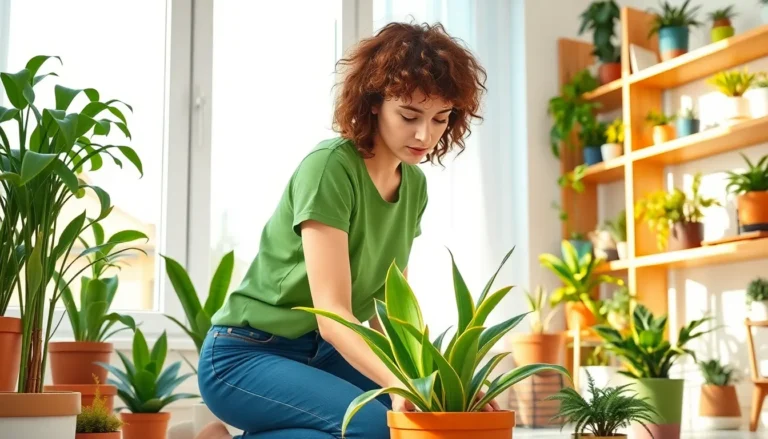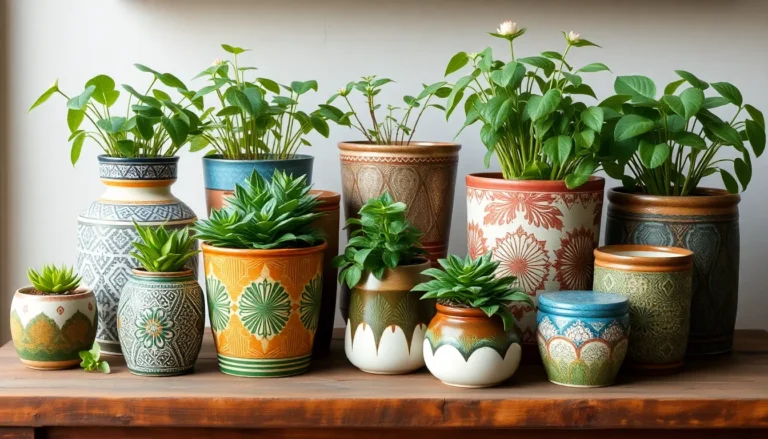Tropical big leaf house plants are the superheroes of indoor greenery, packing a punch with their lush foliage and vibrant energy. Imagine transforming your living space into a mini rainforest, where every corner bursts with life and personality. These leafy giants not only elevate your decor but also work hard to purify the air, making them the perfect sidekick for your home.
Table of Contents
ToggleOverview of Tropical Big Leaf House Plants
Tropical big leaf house plants feature broad, striking leaves that create a dramatic aesthetic in indoor environments. These plants thrive in warm, humid conditions, typically found in their native tropical settings. Varieties such as Monstera, Alocasia, and Philodendron showcase impressive foliage that captures the eye and enhances air quality.
Tropical big leaf plants often have unique shapes and colors that make them focal points in any room. Many species purify indoor air by filtering toxins, thus contributing to a healthier living space. When placed strategically, they can encourage relaxation and improve overall well-being.
Humidity levels play a crucial role in their care. Maintaining increased moisture can help these plants flourish, as they are accustomed to tropical climates. Common care tips include using well-draining soil and providing indirect sunlight to prevent leaf scorch.
Consider the light requirements of each species when integrating them into home decor. Some plants adapt well to low light, while others require bright, indirect light to thrive. Regularly rotating plants can ensure even growth and vibrant foliage.
Overall, tropical big leaf house plants offer both beauty and functionality, making them excellent additions to diverse interior styles. Their lush presence creates a sense of tranquility, connecting indoor spaces with the vibrancy of nature.
Popular Types of Tropical Big Leaf House Plants
Tropical big leaf house plants offer diverse options for enhancing indoor spaces. Below are popular types that homeowners often choose.
Monstera Deliciosa
Monstera Deliciosa, commonly known as the Swiss cheese plant, captivates with its unique leaf perforations. Mature leaves can reach up to 3 feet in width, creating a striking visual impact. This plant thrives in bright, indirect light but can tolerate lower light conditions. Well-draining soil retains moisture without becoming soggy. Regular watering helps keep the soil slightly moist but not waterlogged. Humidity levels around 60% benefit its growth, making occasional misting advantageous.
Philodendron Gloriosum
Philodendron Gloriosum features heart-shaped leaves that can grow up to 2 feet long. These lush, velvety leaves add a touch of elegance to any space. Ideal light conditions include bright, filtered light. Watering requirements include allowing the top inch of soil to dry before the next watering. Soil mix with peat moss enhances drainage and moisture retention. High humidity, around 70%, promotes their vibrant leaf colors.
Alocasia Polly
Alocasia Polly is recognizable for its striking arrow-shaped leaves with prominent veining. This plant typically reaches heights of 2 to 3 feet, making it a dramatic statement piece. It prefers bright, indirect light and needs consistently moist soil. Drainage holes in pots prevent excess water buildup. Regular fertilization during the growing season supports healthy growth. Ideal humidity levels, around 60% to 80%, help maintain its lush appearance.
Benefits of Tropical Big Leaf House Plants
Tropical big leaf house plants provide numerous advantages, making them valuable additions to indoor spaces.
Aesthetic Appeal
Tropical big leaf house plants create stunning visual interest in any room. Striking greens and large leaves mimic a natural rainforest, enhancing the overall decor. Varieties like Monstera or Alocasia serve as statement pieces, drawing attention and sparking conversation. Their unique shapes and sizes add depth to arrangements, making living areas feel more inviting. The lush foliage transforms plain spaces into vibrant habitats, boosting mood and lifestyle. Incorporating these plants fosters a connection to nature, even in urban environments, contributing to overall well-being.
Air Purification
Air quality benefits from tropical big leaf house plants. Many species, including Philodendron and Monstera, actively filter harmful pollutants, improving indoor air freshness. Studies by NASA indicate that certain house plants effectively remove toxins like formaldehyde and benzene. Enhanced air quality supports better respiratory health, promoting a cleaner living space. Regularly maintaining these plants not only contributes to aesthetics but also actively engages in purification efforts. Including them in home environments establishes a serene, healthier atmosphere, ideal for relaxation and productivity.
Care Tips for Tropical Big Leaf House Plants
Caring for tropical big leaf house plants requires attention to specific needs. Each plant has unique requirements, making it essential to understand their care protocols for thriving growth.
Watering Requirements
Watering tropical big leaf house plants involves maintaining a balance. Soil should remain consistently moist but not waterlogged. It’s important to check the top inch of soil before watering. If it feels dry, then it’s time to water. Over-watering can lead to root rot, while under-watering can result in wilting. Frequency may vary by season; they typically need more moisture during active growth in spring and summer.
Light Conditions
Light conditions significantly influence the health of these plants. Most prefer bright, indirect light to flourish. Direct sunlight can scorch their large leaves, so placement near east or north-facing windows is ideal. Some varieties adapt well to lower light settings but may grow slower. Regularly rotating plants can ensure all sides receive equal light, promoting balanced growth and preventing leaning.
Fertilization Tips
Fertilization contributes to vibrant, lush foliage in tropical big leaf house plants. Using a balanced liquid fertilizer every four to six weeks during the growing season enhances nutrient availability. A diluted formula is advisable to prevent fertilizer burn. During winter months, reduce or eliminate feeding, as plant growth slows. Monitoring plant response can help adjust feeding frequency to fit specific needs, ensuring optimal health.
Common Pests and Diseases
Tropical big leaf house plants can face a variety of pests and diseases that threaten their health. Common pests include aphids, spider mites, and mealybugs. Aphids, small and soft-bodied, often cluster on new growth, sucking sap and causing leaves to yellow.
Spider mites may create fine webbing on the undersides of leaves. Regular inspection is essential to catch infestations early. Treating these pests requires methods like insecticidal soap or neem oil, both of which are effective and safe for indoor plants.
Mealybugs, resembling small cottony masses, hide in leaf axils and branch joints. They can weaken plants by draining nutrients. Removing mealybugs involves manually wiping them off or applying alcohol to affected areas.
Diseases such as root rot can develop from overwatering and poorly draining soil. Symptoms include wilting, yellowing leaves, and mushy roots. Ensuring proper drainage with a well-aerated potting mix helps prevent root rot.
Fungal infections may also occur, presenting as leaf spots or powdery mildew. Maintaining good air circulation around plants minimizes the risk of fungal diseases.
Identifying these common pests and diseases quickly protects tropical big leaf house plants. Regular care and monitoring establish a healthy growing environment, allowing these plants to thrive and showcase their beauty.
Tropical big leaf house plants offer a unique blend of beauty and functionality. Their impressive foliage not only enhances interior aesthetics but also contributes to improved air quality. By choosing the right varieties and providing proper care, anyone can create a vibrant indoor oasis that fosters well-being.
These plants thrive in environments that mimic their natural habitats, so understanding their specific needs is essential. With attention to humidity, light, and watering, they can flourish and add a touch of nature to any space. Embracing these lush greens can transform a home into a serene retreat while promoting a healthier living environment.






